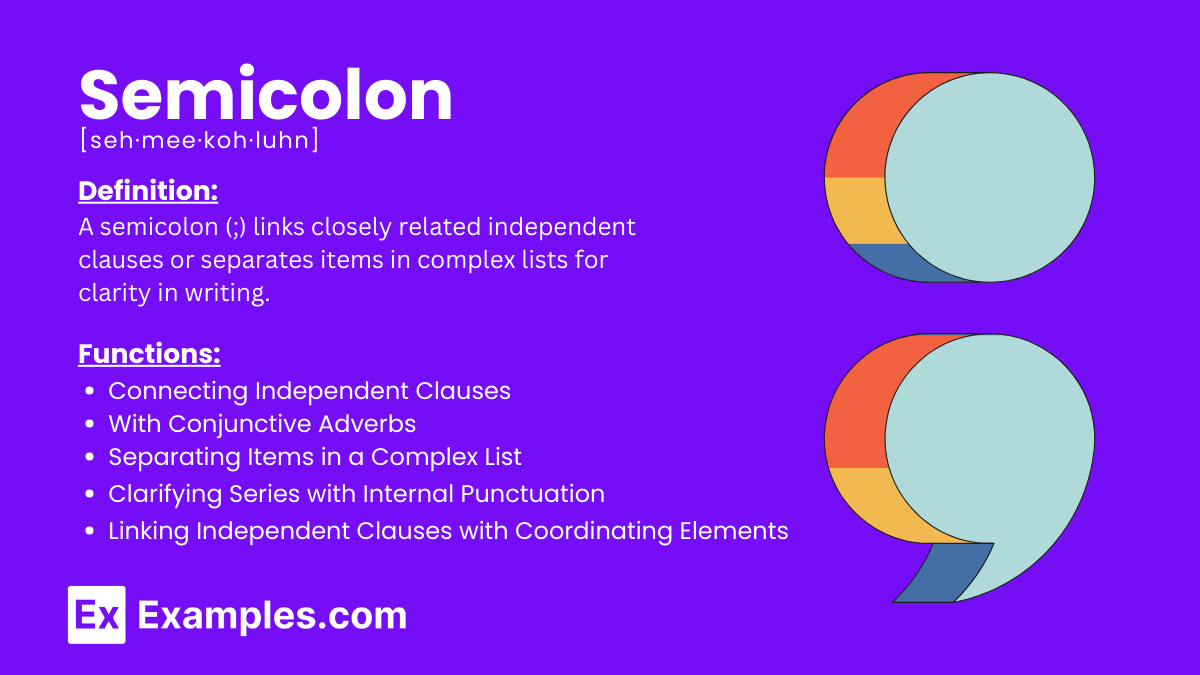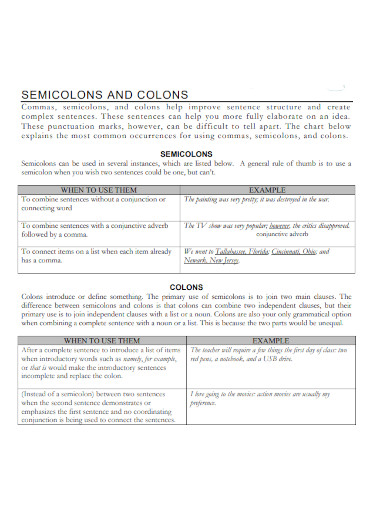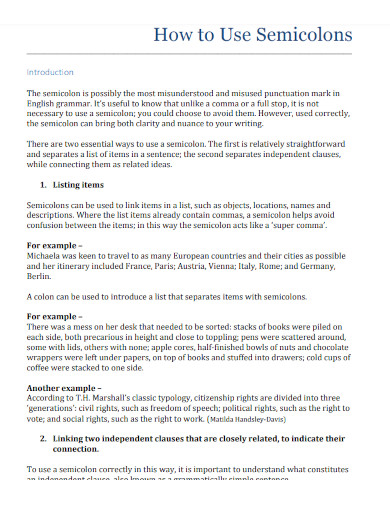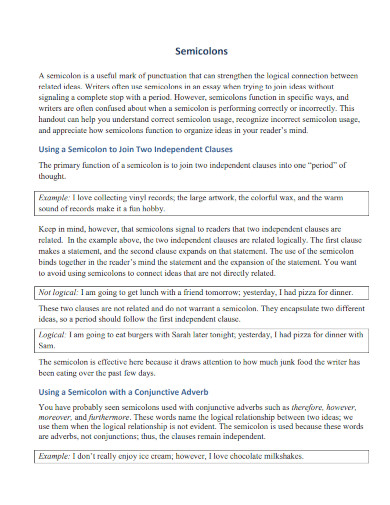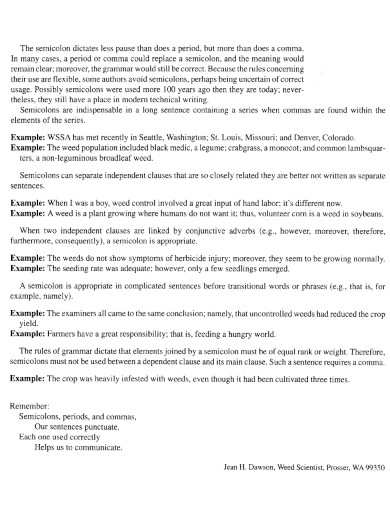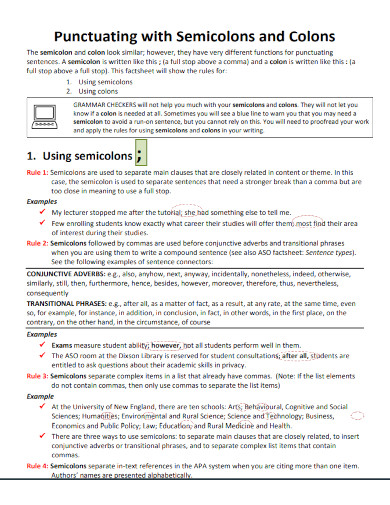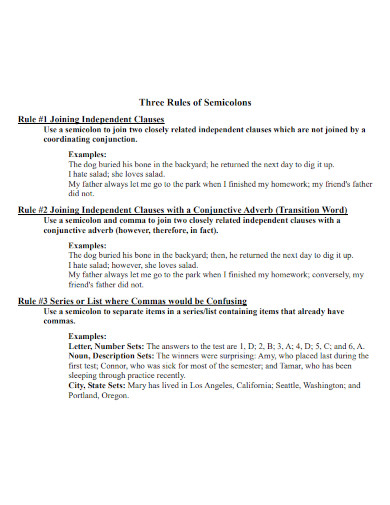70+ Semicolon Examples
Writing is a soft skill that can lead to a hard skill through specialization. When writing becomes a hard skill, it will have a lot of techniques and styles that the writer can use to augment and improve their writing. One of these techniques is in the proper utilization and usage of a semicolon in the writer’s text.
What Is a Semicolon?
A semicolon is a type of punctuation mark that is symbolized by a period above a comma (;). Writers and authors have been using semicolons to subtly and indirectly connect two interrelated ideas and statements into a single sentence.
Examples of Semicolon
Examples of Semicolon in Sentences
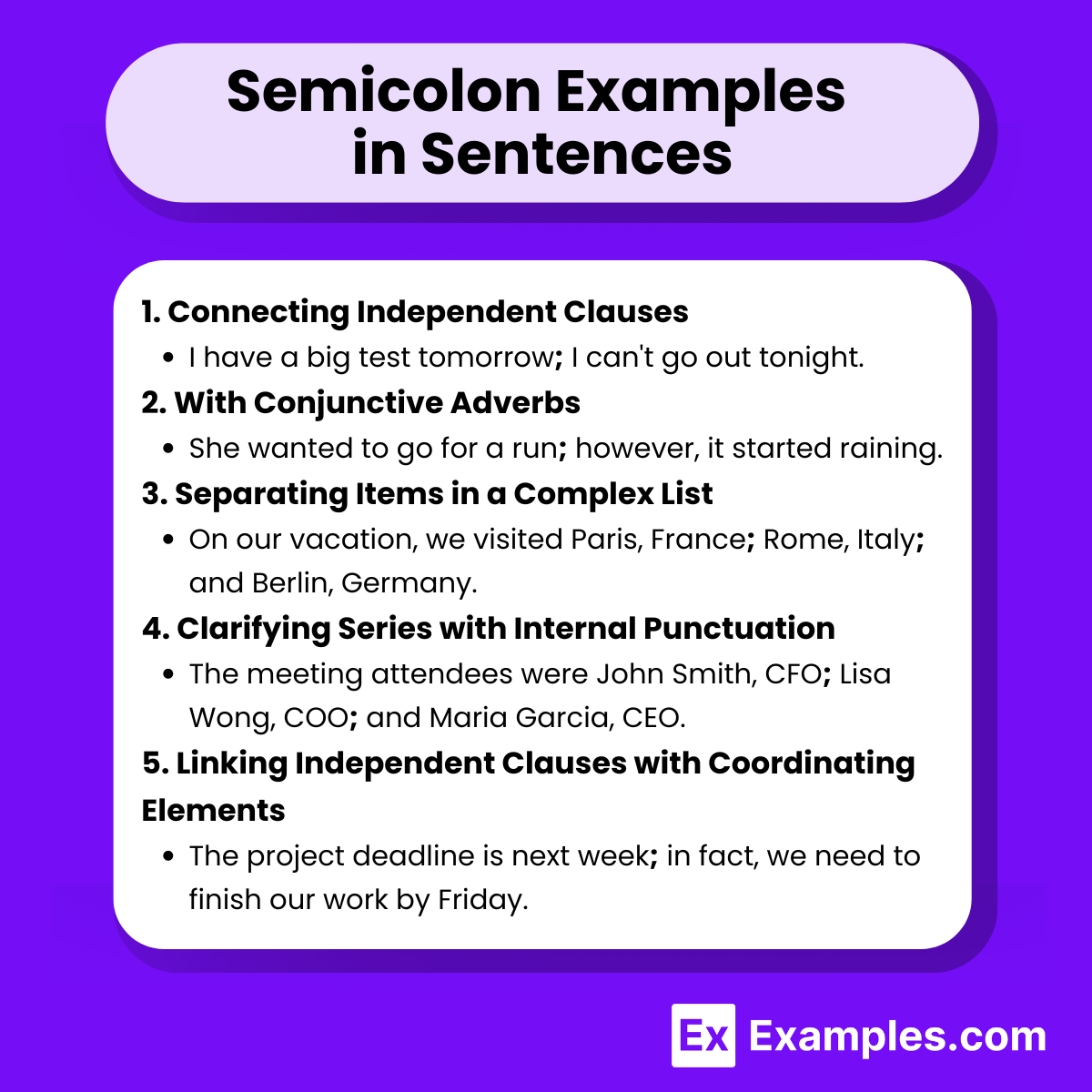
Semicolons can link closely related independent clauses or separate items in a complex list. Here are various examples to illustrate their use in sentences.
Linking Independent Clauses
Semicolons can connect two independent clauses that are closely related but could stand as separate sentences.
Examples:
- I have a big test tomorrow; I can’t go out tonight.
- She studied hard for the exam; she hoped to achieve a high score.
- The weather was terrible; however, we decided to go hiking.
Using Semicolons with Conjunctive Adverbs
When using conjunctive adverbs (however, therefore, moreover, etc.) to connect two independent clauses, a semicolon is used before the adverb, and a comma follows it.
Examples:
- He didn’t see the stop sign; therefore, he ran into the car in front of him.
- The project deadline is approaching; however, we are confident we will finish on time.
- She loves to read novels; moreover, she enjoys writing short stories.
Separating Items in a Complex List
Semicolons can be used to separate items in a list when the items themselves contain commas.
Examples:
- On our trip, we visited Albany, New York; Boston, Massachusetts; and Providence, Rhode Island.
- The conference has participants from Paris, France; Berlin, Germany; and Tokyo, Japan.
- The menu included salads, like Caesar, Greek, and garden; soups, such as tomato, chicken noodle, and vegetable; and desserts, including cake, pie, and ice cream.
Avoiding Confusion
Semicolons help to avoid confusion in sentences where commas are already used for smaller separations.
Examples:
- The meeting included Mr. Smith, the CEO; Ms. Johnson, the CFO; and Mr. Lee, the COO.
- The company has offices in Los Angeles, California; Denver, Colorado; and Austin, Texas.
- My cousins, John, who is a lawyer; Sarah, who is a doctor; and Emily, who is a teacher, all attended the family reunion.
Clarifying a Complex Sentence
Semicolons can be used to provide clarity in complex sentences with multiple clauses.
Examples:
- Although the weather was bad, we decided to go for a hike; the rain stopped eventually, and we enjoyed the rest of the day.
- She finished her homework, which took hours to complete; then, she went out to meet her friends.
- They were tired after the long journey; nevertheless, they were excited to start exploring the new city.
Examples of Semicolon in Words
A semicolon is used to connect closely related ideas and to clarify complex lists. Here are examples of sentences using semicolons with specific words and phrases:
1. However
- She wanted to join the team; however, she missed the deadline for applications.
2. Therefore
- The roads were icy; therefore, the event was postponed.
3. Moreover
- He is an excellent coder; moreover, he understands the principles of good design.
4. Consequently
- She forgot to set her alarm; consequently, she was late for work.
5. Nevertheless
- It was raining heavily; nevertheless, they continued their journey.
6. For Example
- Many fruits are rich in vitamins; for example, oranges are high in vitamin C.
7. In Fact
- The exam was difficult; in fact, most students found it nearly impossible.
8. In Addition
- She completed her thesis on time; in addition, she presented it at a national conference.
9. Thus
- He had all the necessary skills; thus, he was offered the job immediately.
10. Furthermore
- The project was completed ahead of schedule; furthermore, it was under budget.
Examples of Semicolon in Poetry
Semicolons can be effectively used in poetry to create a pause that is stronger than a comma but not as final as a period. They can link closely related ideas and add rhythm and nuance to the poem. Here are some examples of how semicolons can be used in poetry:
1. Connecting Related Images
Waves crash upon the shore; Echoes of a distant time; The moonlight dances gently; Whispers in the night.
2. Enhancing Mystery
Her eyes were pools of mystery; Deep and full of dreams; The stars looked down with envy; At their midnight gleam.
3. Conveying Silence and Depth
The forest stands in silence; Ancient, dark, and deep; Secrets hidden in the shadows; Where ancient spirits sleep.
4. Reflecting on Life’s Fleeting Nature
Life is but a fleeting moment; Time’s relentless march; We find solace in the journey; Underneath the stars.
5. Capturing a Moment of Nature
Morning dew upon the petals; Nature’s gentle kiss; Sunrise breaks the night’s embrace; A moment pure, like this.
6. Finding Hope in Despair
Through the valleys of despair; Hope begins to rise; In the darkest times we find; Strength beneath the skies.
7. Emphasizing Beauty and Contrast
Winter’s chill is bitter; Yet spring brings life anew; The cycle of the seasons; Ever-changing, ever true.
8. Expressing Inner Turmoil
Heartbeats echo in the silence; Thoughts race in the night; Peace is sought but seldom found; In the endless fight.
9. Describing a Journey
Paths diverge in the wood; Decisions must be made; Every step defines us; Every choice we trade.
10. Capturing a Sense of Wonder
Stars above shine brightly; Guiding travelers’ way; In their light, we find our path; Night turns into day.
Semicolon Question Examples
Using semicolons in questions can add complexity and nuance to your writing. Below are examples of how semicolons can be used in different types of questions:
1. Clarifying Related Questions
- Do you need help with your homework; if so, what subject are you struggling with?
- Are you planning to attend the seminar; if yes, have you registered yet?
- Is this your first time visiting our city; if not, when was your last visit?
- Do you want to watch a movie tonight; if yes, which one?
- Are you considering a career change; if so, what field are you interested in?
2. Separating Complex Questions
- What is your opinion on the new policy; do you think it will improve productivity?
- How did you find out about the job opening; did someone refer you?
- Why did you choose to study abroad; was it for the educational benefits or the cultural experience?
- What are the main challenges in your project; do you have a plan to overcome them?
- How do you manage your time effectively; can you share some tips?
3. Linking Multiple Questions
- What are your hobbies; how often do you pursue them; and why do you enjoy them?
- Where will the event be held; what time does it start; and who is the keynote speaker?
- How long have you been working here; what is your role; and what do you enjoy most about your job?
- What are your goals for this year; how do you plan to achieve them; and what motivates you?
- Where do you see yourself in five years; what steps are you taking to get there; and what challenges do you anticipate?
4. Connecting Questions with Conjunctive Adverbs
- Will you be joining us for dinner tonight; however, do you have any dietary restrictions?
- Can you complete the project by the deadline; otherwise, when can we expect it?
- Are you attending the workshop this weekend; nevertheless, do you need any preparation materials?
- Did you enjoy the concert last night; furthermore, are you going to the next one?
- Will you be available for the meeting tomorrow; therefore, can you also prepare the agenda?
5. Combining Questions with Explanatory Phrases
- Can you attend the meeting on Monday; if not, when are you available?
- Is the report ready for review; if not, what still needs to be done?
- Will the presentation be finished by Friday; if not, what is the expected completion date?
- Are you able to work overtime this week; if not, when can you make up the hours?
- Can you join us for the team outing; if not, do you have other commitments?
Semicolon Examples for Kids
Semicolons can be a bit tricky, but they are useful for connecting closely related ideas and organizing lists. Here are some simple examples to help kids understand how to use semicolons in sentences:
1. Connecting Closely Related Ideas
- I have a test tomorrow; I need to study tonight.
- She loves to draw; her favorite thing to draw is animals.
- We went to the park; it was a lot of fun.
- He is great at soccer; he practices every day.
- I made a cake; my brother helped me decorate it.
2. With Conjunctive Adverbs
- I wanted to go to the beach; however, it started to rain.
- She did her homework; therefore, she can watch TV now.
- He was late to class; nevertheless, he didn’t miss much.
- We played outside; consequently, we got really dirty.
- They tried to win the game; however, the other team was better.
3. Separating Items in a Complex List
- My favorite fruits are apples, which are sweet; oranges, which are juicy; and bananas, which are soft.
- We visited New York City, New York; Boston, Massachusetts; and Philadelphia, Pennsylvania.
- In art class, we need pencils, which are sharp; erasers, which are clean; and paper, which is thick.
- Our team includes Jack, the captain; Lily, the goalie; and Sam, the defender.
- For lunch, I had a sandwich, which was delicious; chips, which were crunchy; and a cookie, which was sweet.
4. Clarifying Series with Internal Punctuation
- At the zoo, we saw lions, which are fierce; monkeys, which are playful; and elephants, which are huge.
- The books I read were “Harry Potter,” which is magical; “Percy Jackson,” which is adventurous; and “The Hobbit,” which is fantastic.
- For our party, we invited Sam, who is funny; Alex, who is kind; and Mia, who is smart.
- In the garden, we planted roses, which smell nice; tulips, which are colorful; and daisies, which are bright.
- On our trip, we traveled to Paris, France; Rome, Italy; and London, England.
5. Linking Independent Clauses with Coordinating Elements
- The movie was exciting; in fact, it was the best one I’ve ever seen.
- She loves playing the piano; indeed, she practices every day.
- We went swimming; afterward, we had ice cream.
- He was very tired; as a result, he went to bed early.
- I finished my book; in addition, I started a new one.
More Semicolon Templates and Samples:
1. Semicolon and Colons Template
2. Using Semicolons
3. Semicolons Revised Template
4. Helpful Hints for Technical Writing Semicolon
5. Punctuating with Semicolons and Colons
6. Three Rules of Semicolons
Where should you use a Semicolon
A semicolon is a punctuation mark that can be quite useful when used correctly. Here are the main rules for using semicolons:
1. Connecting Independent Clauses
Use a semicolon to connect two closely related independent clauses that are not joined by a coordinating conjunction (and, but, for, nor, or, so, yet).
Example: I have a big test tomorrow; I can’t go out tonight.
2. With Conjunctive Adverbs
When using conjunctive adverbs (however, therefore, moreover, consequently, otherwise, nevertheless, thus) to connect two independent clauses, use a semicolon before the conjunctive adverb and a comma after it.
Example: She studied for weeks; however, she still felt nervous on the day of the exam.
3. Complex Lists
Use a semicolon to separate items in a list when the items themselves contain commas. This helps to avoid confusion.
Example: The conference has attendees from Paris, France; Tokyo, Japan; Berlin, Germany; and New York, USA.
4. Clarifying Series
Use a semicolon to separate closely related items in a series where commas alone would not provide clarity.
Example: The committee includes John Smith, CFO; Sarah Davis, COO; and David Brown, CEO.
Functions of a Semicolon
A semicolon (;) is a punctuation mark that serves several specific functions in writing. It helps to clarify complex sentences, improve readability, and link closely related ideas. Below are the primary functions of a semicolon:
1. Linking Independent Clauses
A semicolon connects two independent clauses that are closely related but could stand as separate sentences. This emphasizes the connection between the two ideas without using a conjunction.
Example: The sky is clear; the stars are twinkling.
2. Joining Clauses with Conjunctive Adverbs
When joining two independent clauses with a conjunctive adverb (however, therefore, moreover, consequently, otherwise, nevertheless, thus), a semicolon is placed before the conjunctive adverb, followed by a comma.
Example: She wanted to go for a run; however, it started raining.
3. Separating Items in a Complex List
In lists where items contain internal commas, semicolons separate the items to prevent confusion and maintain clarity.
Example: We invited Anna, a software engineer; Bob, a data scientist; and Carla, a UX designer.
4. Clarifying Series with Internal Punctuation
When items in a series or list contain commas, semicolons are used to separate the items clearly.
Example: The panel included Lisa Wong, Professor of Biology; James Smith, Professor of Chemistry; and Maria Garcia, Professor of Physics.
5. Linking Independent Clauses with Coordinating Elements
In cases where independent clauses are connected by a coordinating element (such as transition phrases or time expressions), a semicolon can be used for clarity.
Example: She has lived in Paris for five years; in fact, she speaks French fluently.
When to use a Semicolon?
A semicolon (;) is a versatile punctuation mark used in various contexts to enhance clarity and coherence in writing. Here are the key situations when a semicolon should be used:
1. Connecting Independent Clauses
Use a semicolon to connect two closely related independent clauses that are not joined by a coordinating conjunction (and, but, for, nor, or, so, yet).
Example: She loves to read; her favorite genre is science fiction.
2. Before Conjunctive Adverbs
When using conjunctive adverbs (such as however, therefore, moreover, consequently, otherwise, nevertheless, thus) to connect two independent clauses, place a semicolon before the conjunctive adverb and a comma after it.
Example: The weather was terrible; nevertheless, they decided to go hiking.
3. Separating Items in Complex Lists
Use a semicolon to separate items in a list when the items themselves contain commas. This helps to avoid confusion and ensures clarity.
Example: The itinerary includes stops in Paris, France; Rome, Italy; and Madrid, Spain.
4. Clarifying Series with Internal Punctuation
In a series where individual items contain commas, semicolons are used to separate the items clearly.
Example: The guests included Lisa Wong, the company’s CTO; James Brown, a renowned author; and Sarah Lee, a famous chef.
5. Linking Independent Clauses with Coordinating Elements
Use a semicolon to link independent clauses connected by coordinating elements (such as transition phrases or time expressions) for clarity.
Example: The lecture was fascinating; in fact, it inspired many students to pursue further studies in the field.
Semicolon vs. Colon
| Aspect | Semicolon (;) | Colon (:) |
|---|---|---|
| Primary Function | Connects closely related independent clauses | Introduces lists, explanations, quotes, or examples |
| Usage in Sentences | Links two independent clauses without a conjunction | Precedes a list, explanation, or quotation after an independent clause |
| With Conjunctive Adverbs | Used before conjunctive adverbs (however, therefore) | Not used before conjunctive adverbs |
| Complex Lists | Separates items in lists where items contain commas | Not typically used to separate list items |
| Emphasis | Balances two closely related ideas | Draws attention to what follows, emphasizing it |
| Introductions | Not used to introduce lists or explanations | Introduces lists, explanations, and quotes after a complete sentence |
| Examples in Use | The project is behind schedule; we need to speed up. | She had one goal: to win the championship. |
| Separation | Separates independent clauses without conjunctions | Separates a sentence from its list, explanation, or quote |
| Formality | Generally used in more complex or formal sentences | Used in both formal and informal writing |
How to Use a Semicolon in a Sentence
A well-used semicolon can outline a nuanced relationship between two or more concepts, ideas, statements, and clauses in a subtle manner. If you need a reference you may use any of the semicolon templates and semicolon presentations listed above to improve your technical and creative writing skills.
Step 1: Plan Out the Sentence
Begin by planning out the sentence and the way you will use the semicolon in a said sentence. This will provide you with the necessary amount of context that will help you in the next steps of the how-to.
Step 2a: If Used as a Connector, Write the Independent Clauses
If you are using the semicolon as a connector of two clauses then you must plan out the independent clauses and write them out. Note, the two clauses should have a logical connection or similarity with one another to use the semicolon.
Step 2b: If Used Alongside a Conjunctive Verb, Plan out The Verb and the Clauses
If you are planning on using the semicolon as a connector that will precede the conjunctive verb, then you must plan out both the conjunctive verb and the two clauses. Note that the conjunctive verb will shape the second clause to fit its intention. For example, if one were to use “however” as the conjunctive verb, then the second clause should be something contrary or a juxtaposition of the concept of the preceding statement.
Step 3: Connect the Clauses and All the Parts With a Semicolon
After you have done the steps above, you must now connect the clauses and/or conjunctive verbs into one whole sentence. The placement of the semicolon should be sequestered between the end of the first clause and the beginning of the conjunctive verb or second clause.
What is a semicolon?
A semicolon (;) is a punctuation mark used to connect closely related independent clauses or to separate items in complex lists.
When should I use a semicolon?
Use a semicolon to link closely related independent clauses, separate items in lists with internal commas, and before conjunctive adverbs connecting clauses.
Can a semicolon replace a period?
Yes, a semicolon can replace a period when linking two closely related independent clauses, creating a stronger connection between them.
How does a semicolon differ from a colon?
A semicolon links closely related independent clauses; a colon introduces lists, explanations, or quotations following an independent clause.
Can I use a semicolon before conjunctions like “and” or “but”?
No, semicolons should not be used before coordinating conjunctions like “and,” “but,” or “or.” Use a comma instead.
How do semicolons help in lists?
Semicolons separate items in lists where items contain internal commas, preventing confusion and enhancing clarity.
Is it correct to use semicolons in dialogue?
It’s uncommon. Semicolons are rarely used in dialogue but can be used in complex sentences within dialogue for clarity.
Can a semicolon be used in a question?
Yes, semicolons can connect closely related questions or separate complex question parts, enhancing clarity and flow.
What are common mistakes with semicolons?
Common mistakes include using semicolons with dependent clauses, before conjunctions, and where commas or colons are needed.
Do semicolons improve readability?
Yes, semicolons improve readability by clearly linking related ideas and organizing complex lists, making text easier to understand.



